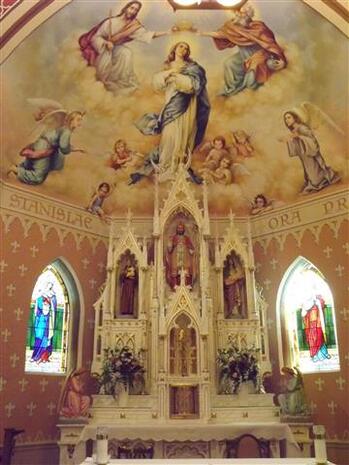A Brief History of St. Stanislaus Catholic Church
|
St. Stanislaus Catholic Church in Bandera, TX was founded by a group of immigrant families from Silesia—a region now primarily in Poland (Latin–Silesia; Silesian–Ślonsk; German–Schlesien; Polish–Śląsk; Czech–Slezko). It was late 1854, when several families arrived in Texas under the guidance of a Franciscan priest, Rev. Leopold Moczygemba, O.F.M. Very early in 1855, pioneer developers, Charles de Montel and John James arranged for some of the families from the group to be transported in ox-carts and dropped off in Bandera. With opportunities to own land, the nearby Medina River offering a good source of water, a working sawmill already established, and a demand for shingles made out of local cypress trees, the immigrants had high hopes of carving out promising lives in Bandera.
|

The church in which we worship today was built in 1876. It was constructed of native limestone. Originally, the sacristy and rectory were located above the rear of the building, the church bell being hung in a small cupola placed on the roof of same area. In 1906 the steeple was completed. The baptistry and confessionals were added in later years, as was a larger bell, and in the 1940’s parish families donated stained glass windows. An all steel steeple with a stainless steel cross was erected in 1988. In her Centennial Year, 1976, the church was adorned with gothic lights, and she was given a complete interior makeover. Six additional stained glass windows were installed in 1990, and in 1996 the statues and Stations of the Cross were repainted, and the altars all re-marbleized. In November 1999, the small room off of the sanctuary was transformed into a chapel for the purpose of Perpetual Adoration. Two additional stained glass windows were installed in the Adoration Chapel and two more in the Sacristy. In 2002, work began on the outside of the church. The limestone rock was cleaned and the old mortar between the limestone was chipped out and replaced. This work was completed in early 2003.
|
After the outside of the church was finished, services were temporarily moved to the Parish Hall so that renovations could begin inside the Church. The wooden floor was removed and replaced with concrete covered by tiles. All the electrical wiring was changed in the church and a new air conditioning/heating system was installed. In addition, a new sound system and electronic bell system were added. Furthermore, three metal doors were replaced, the pews in the church were restored and refinished, a new Confessional was placed in the back of the Church, and a new wooden main door to the Church was added.
Fr. Antoni Polaniak designed and painted the inside of the church, including the ceiling, on which the symbols of the four evangelists were painted. Another artist, Mr. Tomek Tederko, painted a picture in the entrance of the church of Jesus Christ welcoming us. Finally, artist Mr. Cezary Sienkiel and his wife, Eva Sienkiel, painted the pictures on the walls and presbyterium. In the presbyterium, a picture was painted of the Coronation of the Blessed Mother as Queen of Heaven and Earth. Along the walls of the church, Mr. Sienkiel painted pictures representing the short history of St. Stanislaus’ life. Above the doorway as you exit the Church, he painted a picture of the Ten Commandments, and in the choir loft, two angels were painted. Additionally, artist Mr. Cezary Sienkiel did two oil paintings, one of Divine Mercy and one of Our Lady of Guadalupe. These paintings were placed in the two side chapels of the Church. On the front walls of the Church, symbols of the Holy Eucharist were painted, and later, Mr. Sienkiel painted the Adoration Chapel and Sacristy. Thanks to God and the good will of the hard working people of our parish, we finished renovations on the Church in May 2008. |

The building now used as the parish office was built in 1963 as a convent to house the sisters when the old convent was no longer adequate. With the closing of the school, it became the living quarters for the parish priest until 2008.


